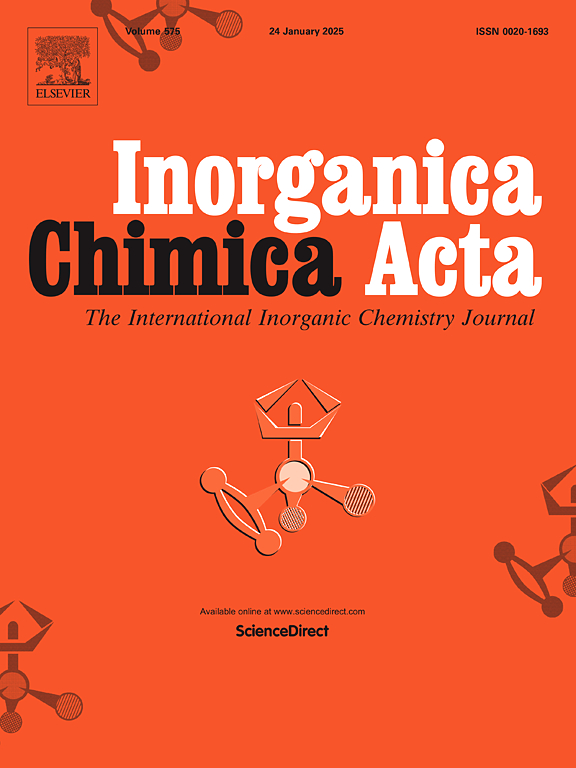Tetravalent thorium and uranium complexes with cucurbit[6]uril: Direct coordination and second-shell interactions
IF 3.2
3区 化学
Q2 CHEMISTRY, INORGANIC & NUCLEAR
引用次数: 0
Abstract
In contrast to the well-established coordination chemistry of cucurbit[6]uril {Q[6]} with lanthanide ions, Q[6] complexes with tetravalent actinide ions are less studied and only limited to thorium(IV) ions. Herein, we report the synthesis and characterization of new Q[6] complexes with thorium(IV) and also extend to uranium(IV) ions. While complexes {[Th(H2O)5Cl]2Q[6]}·2(CdCl4)·2Cl·10H2O (1) and {[Th(H2O)5Cl]2Q[6]}·2(Ru2O2Cl9)·8.666H2O (2) were synthesized by direct reactions of thorium nitrate with Q[6] in 3 M HCl solution with the addition of CdCl2 or RuCl3, complexes {[U(H2O)5Cl]2Q[6]}·2(ZnCl4)·2Cl·6H2O (3) and {U(H2O)9Q[6]}·2(ZnCl4)·12.5H2O (4) were obtained from one-pot reaction of uranyl nitrate and Q[6] in a 6 M HCl solution, with added zinc metal. Both complexes 1 and 2 contain {[Th(H2O)5Cl]2Q[6]}6+ unit with two [Th(H2O)5Cl]3+ species tridentate coordinated to the two portals of Q[6] forming an unsymmetrical closed capsule. Similarly, complex 3 contains a {[U(H2O)5Cl]2Q[6]}6+ unit with two [U(H2O)5Cl]3+ ions tridentate coordinated to the two portals of Q[6], charge balanced with (ZnCl4)2− anions. In contrast, complex 4 has no direct uranium bonding to Q[6], but second-shell interactions through hydrogen bonding. The roles of transition metal chloride species have been discussed. The findings help to improve the fundamental understanding of Q[6] coordination chemistry with tetravalent actinide ions especially extending to uranium(IV) ions.

四价钍铀配合物与葫芦bbbburil:直接配位和第二壳层相互作用
与葫芦bb[6] {Q[6]}与镧系离子的配位化学相比,Q[6]与四价锕系离子的配合物研究较少,仅局限于钍(IV)离子。在此,我们报道了新的Q[6]配合物与钍(IV)的合成和表征,并扩展到铀(IV)离子。硝酸钍与Q[6]在3 M HCl溶液中加入CdCl2或RuCl3直接反应可合成配合物{[Th(H2O)5Cl]2Q[6]}·2(CdCl4)·2Cl·10H2O(1)和{[Th(H2O)5Cl]2Q[6]}·2(Ru2O2Cl9)·8.666H2O(2);硝酸铀酰与Q[6]在6 M HCl溶液中加入金属锌一锅反应可得到配合物{[U(H2O)5Cl]2Q[6]}·2(ZnCl4)·2Cl·6H2O(3)和{U(H2O)9Q[6]}·2(ZnCl4)·12.5H2O(4)。配合物1和2都含有{[Th(H2O)5Cl]2Q[6]}6+单元,两个[Th(H2O)5Cl]3+三叉星与Q[6]的两个入口协调形成一个不对称的封闭胶囊。同样,配合物3含有一个{[U(H2O)5Cl]2Q[6]}6+单元,两个[U(H2O)5Cl]3+离子与Q[6]的两个入口配位,电荷与(ZnCl4)2−阴离子平衡。相反,配合物4与q[6]没有直接的铀键,而是通过氢键进行第二壳层相互作用。讨论了过渡金属氯化物的作用。这些发现有助于提高对Q[6]与四价锕系离子配位化学的基本认识,特别是延伸到铀(IV)离子。
本文章由计算机程序翻译,如有差异,请以英文原文为准。
求助全文
约1分钟内获得全文
求助全文
来源期刊

Inorganica Chimica Acta
化学-无机化学与核化学
CiteScore
6.00
自引率
3.60%
发文量
440
审稿时长
35 days
期刊介绍:
Inorganica Chimica Acta is an established international forum for all aspects of advanced Inorganic Chemistry. Original papers of high scientific level and interest are published in the form of Articles and Reviews.
Topics covered include:
• chemistry of the main group elements and the d- and f-block metals, including the synthesis, characterization and reactivity of coordination, organometallic, biomimetic, supramolecular coordination compounds, including associated computational studies;
• synthesis, physico-chemical properties, applications of molecule-based nano-scaled clusters and nanomaterials designed using the principles of coordination chemistry, as well as coordination polymers (CPs), metal-organic frameworks (MOFs), metal-organic polyhedra (MPOs);
• reaction mechanisms and physico-chemical investigations computational studies of metalloenzymes and their models;
• applications of inorganic compounds, metallodrugs and molecule-based materials.
Papers composed primarily of structural reports will typically not be considered for publication.
 求助内容:
求助内容: 应助结果提醒方式:
应助结果提醒方式:


